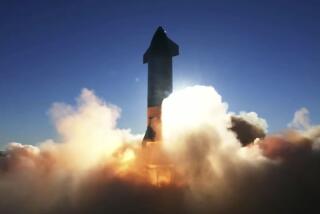Lockheed Will Produce Plane for U.S. Customs to Fight Drug Smuggling
- Share via
Lockheed said Wednesday that it will launch production of a new airborne early warning aircraft program on a $19.7-million contract issued to the company by the U.S. Customs Service.
The new aircraft, which is a derivative of the Navy P-3 Orion anti-submarine patrol aircraft, features a long-range radar system with an antenna mounted in a 24-foot rotodome atop the fuselage, similar to the well-known Boeing E-3 Airborne Warning and Control System (AWACS) planes.
The Customs Service plans to use the Orion to track and intercept drug smugglers in small aircraft and boats in the Caribbean. The Customs service would fly patrols as far south as Colombia, the origin of most cocaine imported illegally into the United States.
“The addition of this aircraft to our fleet puts us on the brink of success,” said Michael H. Lane, Customs Service deputy commissioner. “The P-3 will contribute immense versatility to our leadership in air interdiction, both in early detection and in executing airborne command and control procedures.”
‘Half the Price’
Lockheed hopes the Customs Service order will open a potentially large market of foreign nations that need an airborne radar capability but cannot afford the costly Boeing AWACS system.
“We have the capability and the endurance of the AWACS at half the price,” said E. Lloyd Graham, executive vice president of Lockheed-California Co., the Burbank-based producer of military aircraft. “Any customer who is concerned about price is a potential customer.”
Lockheed has developed the Orion radar aircraft over the past five years, investing $20 million of company funds. It is one of only a handful of ventures that the aerospace industry has undertaken to develop weapons systems without Pentagon funding. The Northrop F-20 was the most notable example of such ventures.
General Electric produces the Orion’s radar, which is able to detect small boats and aircraft at ranges of 200 miles as well as larger targets all the way to the horizon, a Lockheed spokesman said.
Estimating the Demand
Graham said other potential customers include Australia, Japan and Canada. The worldwide market may be as large as 100 aircraft, he said. That would probably be split between the three producers of early warning aircraft--Lockheed, Boeing and Grumman with its short-range Hawkeye, which is based on aircraft carriers.
The Customs Service got a special deal for its Orion of $19.7 million, because the service was the launch customer for the program and because the plane will be built on a refurbished Orion airframe that was previously owned by Australia, Graham said. The aircraft will be offered in the future at prices of about $60 million, Graham said.
The Customs Service award came in the form of a letter contract that is subject to approval of a fiscal 1987 supplemental appropriation by Congress. The bill has already cleared the House and Senate and is now subject to action by a conference committee.
More to Read
Inside the business of entertainment
The Wide Shot brings you news, analysis and insights on everything from streaming wars to production — and what it all means for the future.
You may occasionally receive promotional content from the Los Angeles Times.











